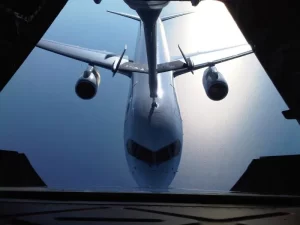Table of Contents
Distance
Near-field and far-field antenna measurements differ primarily based on the actual physical distance from the antenna at which the measurements take place. Both the method of measurement and its practical application are significantly affected by this defining variable. Near-field measurements typically occur within a few wavelengths of the antenna. With a standard WiFi antenna operating at 2.4 GHz, the wavelength is approximately 12.5 cm. Thus, near-field measurements might take place at a distance of 37.5 cm or less. The purpose of making a measurement at this proximity is the analysis of the electromagnetic field immediately around the antenna, as understanding this region is instrumental in the adjustment and fine-tuning of antenna designs in compact gadgets or satellite systems.
Far-field measurements take place at a much larger distance, which can be calculated as 2 D ^2 / λ, where D represents the largest antenna dimension. Thus, in a television broadcast antenna whose size is typically around 10 m, using the same WiFi wavelength, the far-field measurement would occur at 800 meters or more. The definition necessary for this form of measurement is the propogation of the antennas radiative field, which is crucial for assessing how the antenna will actually function when broadcasting signals across a sizable area.
Both of these measurement methods serve different practical purposes. Engineers manufacturing WiFi routers or mobile phones will primarily use near-field methods to ensure that their antennas are ideally placed within a tight compartment, with no interference from other device mechanisms and maximum signal strength. Far-field measurements will be used in applications such as radio telescopes or other point-to-point broadcasts, where the primary need is to accurately evaluate the effectiveness and range of the antenna in signal transmission over a considerable distance.

Field Characteristics
Analyzing the field characteristics of near-field and far-field measurements, it becomes evident that they differ substantially and that such differences have a direct impact on their applications, ranging from consumer electronics to large-scale communications systems. First, near-field measurements deal exclusively with the reative part of the electromagnetic field. This region is defined by electric and magnetic fields that do not radiate but rather store energy around the antenna. Still, the stored energy can vary drastically over short distances, typically from multiple centimeters to less than a centimeter. For example, the RFID systems rely on antennas stored mostly in the near-field region right next to RFID tags. In the far-field region, the energy may be stored or captured by the antenna but must radiate out of it, resulting in a field adherent to the inverse square law.
Such a characteristic is critical for applications like broadcasting, where the signal must be both consistent and strong over a large region. For instance, if an FM radio station broadcasts at 100 MHz with a 3-meter-long wave interva l, the signal should be caught beyond a couple of kilometers. Both field regions require radically different measurement tools. In the near-field, the complex electromagnetic fields are typically measured in multiple directions using special scanners and probes to understand the dynamics of the environment they form around the antenna. The ability to measure the field complexly and map the near-field environment must be of paramount importance for applications like the smartphone industry, which packs a number of different components into a small area.
These relatively cheaper and more effective measurement tools are still bound to increase the cost of the devices to a certain degree by demanding some degree of complexity in their construction. On the other hand, far-field measurements must shift their focus to determine how well the antenna projects the energy fields away from it. Receiving either clear signals or none at all, applications like satellite communication and radar will need to perform such measurements to ensure the cost-effective construction of their devices. Overall, near-field measurements risk increasing the cost and complexity of the device due to the complicated setups and the need to understand the complex field around the smaller device. Far-field measurements, while less demanding, still require extensive space and other resources to ensure the quality of the broadcast or retarded field.
Purpose
The purpose of near-field and far-field measurements is closely connected to the application of the technologies and conditions in which antennas need to operate. In particular, near-field measurements are designed to help understand the highly complicated electromagnetic environment near the antenna. Since modern devices incorporate a vast number of electronic components, it is essential to adjust the design to minimize interference and ensure the efficient work of each separate element. In particular, near-field measurements are massively critical in creating antenna systems for devices that can overcome physical and environmental limitations and remain functional in real-world scenarios. For instance, when smartphones are designed, one of the primary objectives is to ensure that the inbuilt antenna does not interfere with the other components: the battery, the screen, the camera, and others. Near-field measurements help determine the optimal shape and positioning for the antenna, ensure the strongest connection, and prevent undesirable interference. Finally, the data from these measurements can also provide some information about what materials or other design elements can help create the most efficient device overall.
As for the far-field measurements, their purpose is to evaluate what signals an antenna will be able to transmit at receive in real-world scenarios at larger distances. This task is critical in multiple applications, including those where the need to connect over large distances is frequent. Examples include satellite communication, television broadcasting, and long-range radar systems. For instance, if a television broadcasting station wants to send a signal to people living within 100 km of its location, it must ensure the geometry of the far-field radiation pattern that could guarantee the reception of clear signals to the viewers. Overall, this task is no less important than that of near-field measurement. Both types of measurements directly influence the goals of the project and, as a result, the associated costs and time required to implement or develop them. On one hand, near-field testing is known to be quite intense, demanding, and likely expensive, because it requires specialized equipment and may result in more significant additional costs through the number of re-tests required to ensure appropriate placing of the antenna. On the other hand, far-field testing is less demanding in terms of technology but can be so in terms of logistics, since one needs to have enough space to test, leading to increased costs anyway.
Applications
While antennas serve as a common element of virtually all wireless communication and information transmission devices, the successful integration into the targeted technology requires precise assessment and calibration. Two of the most critical protocols in this account are near-field and far-field measurement, both offering different advantages and applications across the spectrum of technologies.
While near-field measurements are substantially important across industries where antennas need to be accommodated in a very small space alongside other nearby electronic installations, near-field measurement is also vital in applications designed to be worn or attached to the human body. An industry that leans heavily on near-field measurements is the production of the smartwatches or fitness trackers with the minimal distance between their antenna and the wearer. Here, the product designer needs to use this method to measure the proximity effect to the skin and near-field source to other electronic components, such as screens or battery, antennas. It informs the RF engineers on the exact absorption mechanism, which is especially critical in technological devices calibrated to offer actual health information, such as blood pressure measurements. By using this type of measurement, product developers and engineers can measure the antenna’s fields in extreme proximity to the users and use the generated information to deliver effective yet battery-efficient transmission.
On the other hand, far-field measurement is vital in technology specifically designed to send signals over a long distance. Several of these systems are located in space, such as satellites and houses for geo-location systems. For this reason, the stability of the signal, and therefore the far field of the antenna, is of paramount importance to resilience and tampering. It should also be mentioned that the radar systems used by both the air force and civilian air traffic control utilize the functionalities of the far field.







